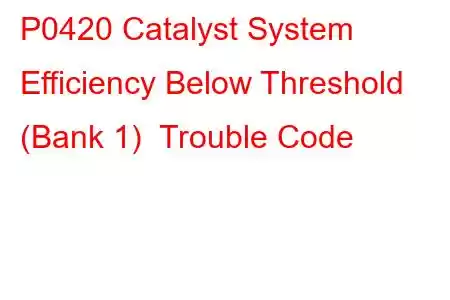P0420 Catalyst System Efficiency Below Threshold
Technical Description
Catalyst System Efficiency Below Threshold (Bank 1)
What does that mean?
This diagnostic trouble code (DTC) is a generic powertrain code. It is considered generic because it applies to all makes and models of vehicles (1996-newer), although specific repair steps may be slightly different depending on the model. So this engine code article applies to Nissan, Toyota, Chevrolet, Ford, Honda, GMC, Subaru, VW, etc.
P0420 is one of the more common trouble codes that we see. Other popular codes include P0171, P0300, P0455, P0442, etc. So be sure to bookmark this site for future reference!
The catalytic converter is a part of the exhaust system that looks kind of like a muffler, although it's job is very different from that of a muffler. A catalytic converter's job is to reduce emissions from the exhaust.
The catalytic converter has an oxygen sensor in front and behind it. When the vehicle is warm and running in closed loop mode, the upstream oxygen sensor waveform reading should fluctuate. The downstream O2 sensor reading should be fairly steady. Typically the P0420 code triggers the Check Engine Light if the readings of the two sensors are similar. Oxygen sensors are also referred to as O2 sensors.
This is indicative of (among other things) a converter that is not working as efficiently as it should be (according to specs). Catalytic converters are not normally a "wear" type item, that is they are not designed to wear out and need replacement. If they have failed, it is likely due to something else that caused it to fail. This is what a P0420 means in simplified terms.
Symptoms
The main symptom to the driver is the illumination of the MIL (malfunction indicator lamp). You will likely not notice any drivability problems, although there may be symptoms. For example, if the substance inside the catalytic converter is broken or failed, it may be restricting the exhaust which will result in a feeling of reduced power output from the vehicle.
Causes
A code P0420 may mean that one or more of the following has happened:
Leaded fuel was used where unleaded was called for (unlikely) A damaged or failed oxygen / O2 sensor Downstream oxygen sensor (HO2S) wiring damaged or connected improperly The engine coolant temperature sensor is not working properly Damaged or leaking exhaust manifold / catalytic converter / muffler / exhaust pipe Failed or underperforming catalytic converter (likely) Retarded spark timing The oxygen sensors in front and behind the converter are reporting too similar of readings Leaking fuel injector or high fuel pressure Cylinder misfire Oil contaminationPossible Solutions
Some suggested steps for troubleshooting and fixing a P0420 error code include:
Check for exhaust leaks at the manifold, pipes, catalytic converter. Repair as required. Use a scope to diagnose the oxygen sensor operation (Tip: The oxygen sensor in front of the catalytic converter normally has a fluctuating waveform. The waveform of the sensor behind the converter should be more steady). Inspect the downstream heated oxygen sensor, replace if necessary Replace the catalytic converterDiagnostic Tip
Generally speaking you can look at the temperature of the exhaust just before and just after the converter using an infrared temperature gun. The output should be about 100 degrees Fahrenheit hotter when the engine is fully warmed up.
Overall probably the biggest mistake vehicles owners make when they have a P0420 code is to simply replace an oxygen sensor (02 sensor). It is important to do proper diagnosis so you're not wasting money replacing parts unnecessarily.
We strongly recommend that if you need to replace the catalytic converter that you replace it with an original manufacturer brand unit (i.e. get it from a dealership). Second choice would be a high-quality replacement part such as a 50-state legal cat. There are many stories in our forums where folks replaced the cat with a cheaper aftermarket one only to have the code return shortly thereafter.
One thing to note is that many vehicle manufacturers offer a longer warranty on emissions-related parts. So if you have a newer car but it's out of it's bumper-to-bumper warranty, there still may be warranty on this type of problem. Many manufacturers give a five year, unlimited mileage warranty on these items. It's worth checking into.
See also: P0420.com - P0420 Help
Read: 50


